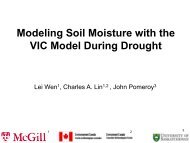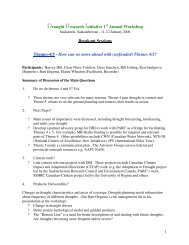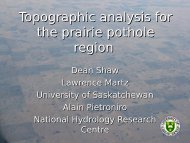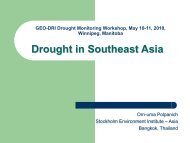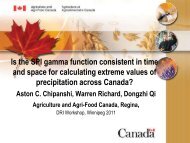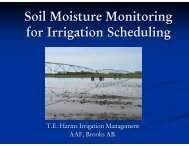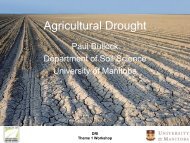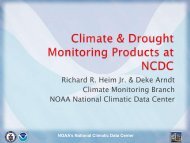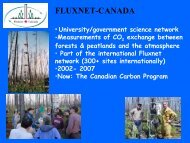Applications of a Climate Moisture Index for Assessing Impacts of ...
Applications of a Climate Moisture Index for Assessing Impacts of ...
Applications of a Climate Moisture Index for Assessing Impacts of ...
You also want an ePaper? Increase the reach of your titles
YUMPU automatically turns print PDFs into web optimized ePapers that Google loves.
<strong>Applications</strong> <strong>of</strong> a <strong>Climate</strong> <strong>Moisture</strong> <strong>Index</strong> <strong>for</strong>assessing impacts <strong>of</strong> the 2001-2002 drought onaspen <strong>for</strong>ests in the Prairie Provinces1E.H. (Ted) Hogg, 1 J.P. Brandt, 1 M. Michaelian,1D.T. Price, 1 M. Siltanen & 2 D.M. McKenney1Northern Forestry Centre, Canadian Forest Service, Natural Resources CanadaEdmonton, Alberta2Great Lakes Forestry Centre, Canadian Forest Service, Natural Resources CanadaSault Ste. Marie, OntarioDrought Research Initiative Workshop #211-13 13 January 2007, Winnipeg, Manitoba
Two major methods <strong>for</strong> measuring “drought”1. “Relative indicators”Provide a measure <strong>of</strong> moisture relative to the long-term meanand variability at a given locatione.g., Standardized Precipitation <strong>Index</strong>, Palmer Indices2. “Absolute indicators”Provide a measure <strong>of</strong> moisture conditions as they affect biophysicalprocesses such as fire (fuel moisture), vegetation (soil moisture)& stream flow (water run<strong>of</strong>f)e.g., Canadian Fire Weather <strong>Index</strong> System<strong>for</strong> assessing <strong>for</strong>est fire risk<strong>Climate</strong> <strong>Moisture</strong> <strong>Index</strong><strong>for</strong> assessing <strong>for</strong>est-climate relationships
<strong>Climate</strong> <strong>Moisture</strong> <strong>Index</strong> (CMI)A simple index <strong>for</strong> assessing moisture regimes in remote <strong>for</strong>ested regionswhere long-term climate data are typically limited to temperature and precipitationpitationCMI = P - PET(units in cm/year)P is mean annual precipitation(includes water input as both rain and snow)PET is annual potential evapotranspiration(loss <strong>of</strong> water vapour from well-vegetated landscape)PPETMethods <strong>for</strong> estimating PET:1. Jensen-Haise (mean monthly solar radiation, temperature, and elevation)2. Simplified Penman-Monteith (maximum and minimum temperature, elevation)From Hogg (1994) Can. J. For. Res. 24: 1835-1845and Hogg (1997) Agric. For. Meteorol. 84: 115-122.run<strong>of</strong>f
Application <strong>of</strong> the <strong>Climate</strong> <strong>Moisture</strong> <strong>Index</strong>:Analysis <strong>of</strong> climatic factors affecting <strong>for</strong>est distribution underpresent and projected future climate (Hogg and Hurdle 1995)From Hogg, E.H. and P.A. Hurdle. 1995. The aspen parkland in western Canada: A dryclimateanalogue <strong>for</strong> the future boreal <strong>for</strong>est? Water, Air and Soil Pollution 82: 391-400.
<strong>Applications</strong> <strong>of</strong> the CMI (continued):Studies <strong>of</strong> drought impacts on <strong>for</strong>est growth & diebackCIPHA:<strong>Climate</strong> <strong>Impacts</strong> on Productivity & Health <strong>of</strong> aspen• Started in 2000 by Hogg, Brandt and Kochtubajdain response to concerns about aspen diebackBERMS• Annual monitoring <strong>of</strong> aspen <strong>for</strong>est healthin 25 study areas (75 stands)•Includes tree-ring analysis <strong>of</strong> past growthBARK2000Aspen tree-rings1990BERMS Old Aspen sitePrince Albert National Park
Results:CIPHA tree-ring ring analysistotal <strong>of</strong> 432 aspen trees sampledMain factors affecting aspen growth:• <strong>Climate</strong> <strong>Moisture</strong> <strong>Index</strong> (CMI)<strong>for</strong> 1 August-31 July (‘tree(water year”)• Insect defoliation (D)mainly <strong>for</strong>est tent caterpillarDry CMI MoistDetrended growth (A’)Interannual variation inthe regional CMIDrought yearsDefoliation years2001-02droughtRegression: A’ = 1.169 + 0.0111 CMI + 0.0099 CMI -1+ 0.0071 CMI -2+ 0.0058 CMI -3+ 0.0055 CMI -4–0.0119 D, r 2 =0.697From Hogg et al. 2005, Can. J. For. Res.(results updated to 2004)
<strong>Impacts</strong> <strong>of</strong> the 2001-2002 2002 drought• Severe aspen mortality in the parklands <strong>of</strong> Sask. & Alberta(resembling fire in some areas!)Annual stem mortality (%)• Conifers and urban trees also affected• Aspen mortality in CIPHA plots increasedin the 4 years following the drought• Spatial variation in mortality best correlatedwith drought severity (minimum CMI)654321200020012001200220022003Year200320042004200520052006Severe aspen mortalityfollowing drought nearNorth Battle<strong>for</strong>d, Sask.(Michaelian, Aug. 2004)Mortality (%)403020100Drought-damagedaspen foliageAugust 2002Aspen dieback atBatoche, Sask.May 2003Mortality <strong>of</strong> aspen biomassduring 2000-2005y = 0.0033x 2 - 0.1297x + 5.529R 2 = 0.3659-50 -40 -30 -20 -10 0Minimum one-year CMI(2000-2005)
<strong>Impacts</strong> <strong>of</strong> the 2001-2002 droughtAerial survey <strong>of</strong> aspen mortalityAugust 2004, CIPHA studyFlight linesBERMS (BOREAS)Flux tower site,Prince AlbertNational ParkDrought was theworst on recordacross most <strong>of</strong> thearea surveyedPrince AlbertMORTALITYLightModerateSevereCIPHA siteForestFireSurveys and preliminary map by M. MichaelianDrought-induced aspenmortality at Fort Carlton,Sask., August 2006
DRY MOISTMapping <strong>of</strong> the CMI For monitoring & retrospective analyses<strong>of</strong> <strong>for</strong>est responses to drought-60 -30 0 +30 +60 +90<strong>Climate</strong> <strong>Moisture</strong> <strong>Index</strong> (CMI)30-year mean1961-199019902001-20022002Methods:• uses 10-kmgridded elevation and monthly temperature & precipitation (1901-2003)• interpolation by ANUSPLIN <strong>for</strong> all <strong>of</strong> Canada (McKenney(et al.)• applied CMI equations (P – PET) <strong>for</strong> 12-month periods ending 31 JulyArea covered by aerial survey<strong>of</strong> aspen dieback and mortality
Mapping <strong>of</strong> the CMIComparison with previous prairie drought yearsDRY MOIST-60 -30 0 +30 +60 +90<strong>Climate</strong> <strong>Moisture</strong> <strong>Index</strong> (CMI)30-year mean1961-199019901960-196119612000-200120011936-193719371987-198819882001-20022002In the affected areas <strong>of</strong> aspen parkland, the 2001-2002 2002 drought was moresevere than during some previous well-known years <strong>of</strong> prairie drought
Mapping <strong>of</strong> the CMIComparison with previous boreal drought yearsDRY MOIST-60 -30 0 +30 +60 +90<strong>Climate</strong> <strong>Moisture</strong> <strong>Index</strong> (CMI)30-year mean1961-199019901940-194119411979-198019801918-191919191963-196419642001-20022002But: there were other years with a more northerly extent <strong>of</strong> drought that were <strong>of</strong>comparable severity to the 2001-2002 2002 drought in parts <strong>of</strong> the CIPHA study region
Future applications <strong>of</strong> the CMI• “Scaling up” regional-scale impacts <strong>of</strong> the recent droughtIncludes remote sensing component (with Hall, Arsenault et al.)• <strong>Assessing</strong> impacts <strong>of</strong> recent drought on C uptake & release• Estimating impacts <strong>of</strong> past droughts on <strong>for</strong>est growth, biomass and C uptake• <strong>Assessing</strong> risks to urban <strong>for</strong>ests, plantations & af<strong>for</strong>estation projectsSee Volney et al. (2005), Unasylva 221: 20-2525• Inclusion <strong>of</strong> drought as a disturbance type in <strong>for</strong>est carbon accountingcountingPotential <strong>for</strong> inclusion in the CFS Carbon Budget Model (Kurz(et al.)• Development <strong>of</strong> climate-driven models <strong>of</strong> <strong>for</strong>est growth & diebackPotential tool <strong>for</strong> managing <strong>for</strong>ests under a changing climate
CIPHA investigatorsE.H. Ted HoggJames BrandtRon HallAnthony Hopkin (GLFC)Bob Kochtubajda (EC)ResearchcollaborationsAlan Barr (EC)Pierre Bernier (LFC)Andy Black (UBC)Jag BhattiOlivier BouriaudPraveena Krishnan (UBC)Werner Kurz (PFC)Vic Lieffers (U <strong>of</strong> A)Dan McKenney (GLFC)David PriceKen van Rees (U <strong>of</strong> S)Alison Theede (U <strong>of</strong> S)and othersTeam members & collaboratorsData management& analysis systemsMike MichaelianForest healthcrew leadersMike MichaelianTrisha HookAl Keizer (GLFC)Michael SalomonsRoger Brettand othersTree-ringringanalysesFunding (CIPHA study)Trisha HookMichael SalomonsThierry Varem-Sandersand othersAerial surveys &remote sensingsystemsMike MichaelianEric ArsenaultRob Skakun<strong>Climate</strong> Change Action FundProgram <strong>of</strong> Energy Research and DevelopmentMistik Management Ltd., Meadow Lake, Sask.Forest 2020AAFC – PFRA AdministrationCFS <strong>Climate</strong> Change and Forest Health groupsField & laboratoryassistanceJim HammondRick HurdleRoger Nesdoly (MM)Brad TommJim WeberBrian ChristensenAndrea DurandRay Fidler (PC)Angela JohnsonSarah MartinRyan RaypoldErin Van OverloopMark SchweitzerJessica SneddenBill van EgterenBryan VroomDave Wieder (PC)and others



